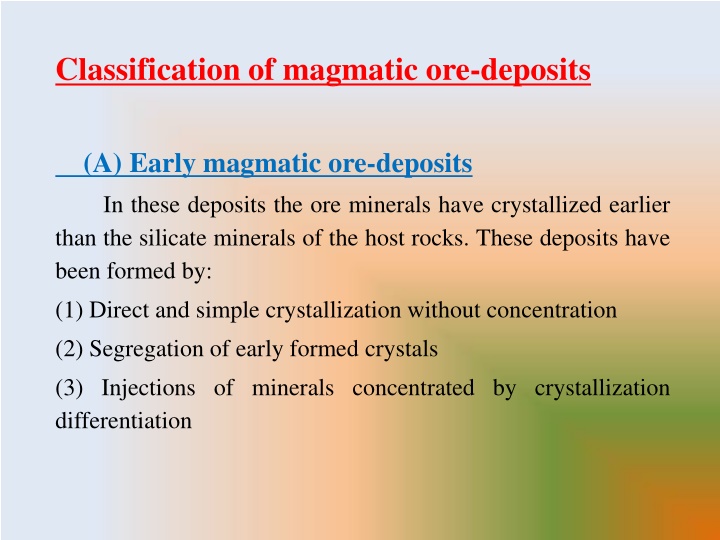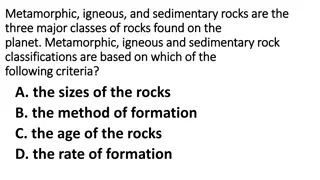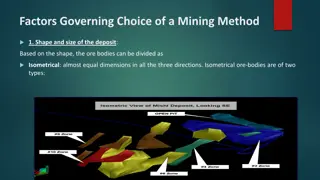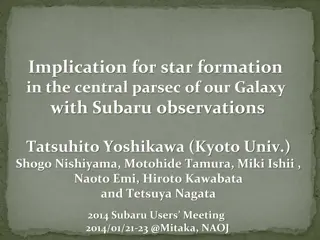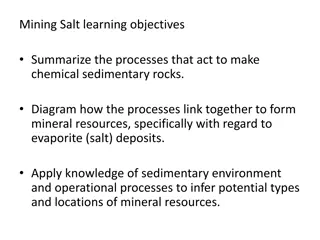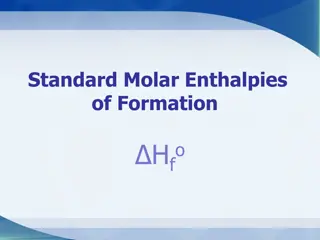Early Magmatic Ore Deposits: Formation and Types
Early magmatic ore deposits are formed by direct crystallization, segregation of early crystals, or injections of concentrated minerals. They can be subdivided into disseminated deposits, segregation deposits, and injection deposits, each with unique characteristics and formation processes. Examples include diamond pipes in South Africa and chromite segregation bodies. Understanding the formation of these ore deposits is crucial in the field of geology and mining.
Download Presentation

Please find below an Image/Link to download the presentation.
The content on the website is provided AS IS for your information and personal use only. It may not be sold, licensed, or shared on other websites without obtaining consent from the author.If you encounter any issues during the download, it is possible that the publisher has removed the file from their server.
You are allowed to download the files provided on this website for personal or commercial use, subject to the condition that they are used lawfully. All files are the property of their respective owners.
The content on the website is provided AS IS for your information and personal use only. It may not be sold, licensed, or shared on other websites without obtaining consent from the author.
E N D
Presentation Transcript
Classification of magmatic ore-deposits (A) Early magmatic ore-deposits In these deposits the ore minerals have crystallized earlier than the silicate minerals of the host rocks. These deposits have been formed by: (1) Direct and simple crystallization without concentration (2) Segregation of early formed crystals (3) Injections of minerals concentrated by crystallization differentiation
Accordingly early magmatic ore deposits can be subdivided into: (1) Disseminated magmatic ore-deposits Simple crystallization of deep seated magma will yield a granular igneous rocks in which the early formed ore crystals are disseminated and abundant, the whole rock or a part becomes the ore body. The resulting deposits of this type have the shape of the intrusive, which may be a dike, pipe, or small stock like mass. Examples: the diamond pipes of South Africa and the disseminated corundum in nepheline syenite in Ontario
(2) Early magmatic segregation ore-deposits Segregation means concentration of early crystallizing minerals in place. Accordingly, early magmatic concentrations of valuable constituents of the magma that have taken place, because of gravitative crystallization differentiation . Such constituents as chromite may crystallize early and become segregated in bodies of sufficient size and richness to form economic ore-deposits. The segregation may take place by the sinking of heavy early formed crystals to the lower part of the magma chamber, by marginal accumulation, or by constructional flowage. The mineral deposits formed by early segregation are generally lenticular and of small size. Commonly, they are disconnected pod-shape lenses, and bunches. Less commonly, they form layers in the host rocks. segregations are early
(3) Early magmatic injections ore-deposits The ore minerals have been concentrated by crystallization differentiation and are earlier than or contemporaneous with the associated rock silicate minerals. They have not remained at the place of accumulation, but have been injected into the host rock or surrounding rocks. They transect enclosing rocks and even metamorphose the wall rocks. Examples the Ti- magnetite dike of Cumberland.
